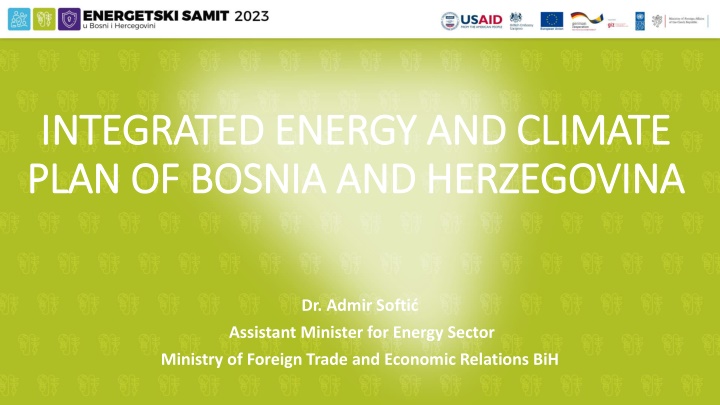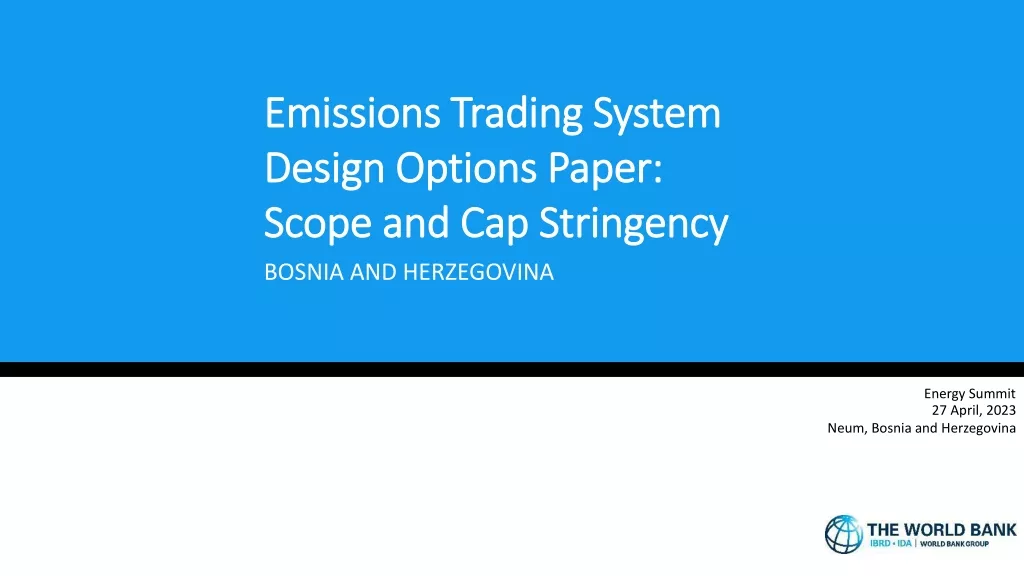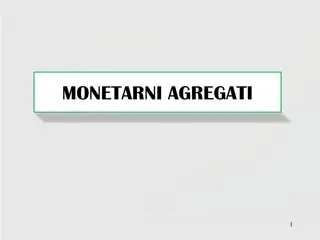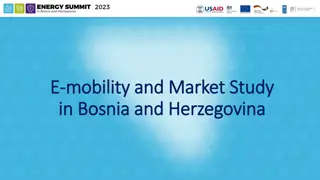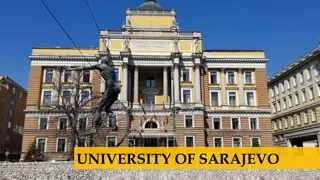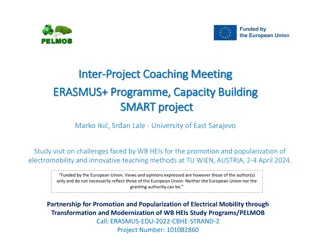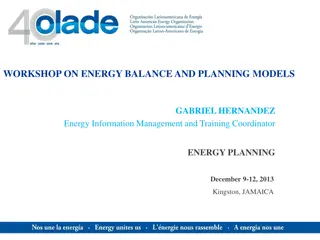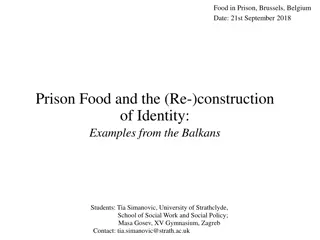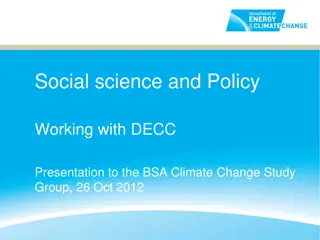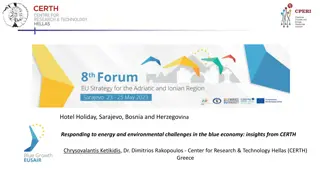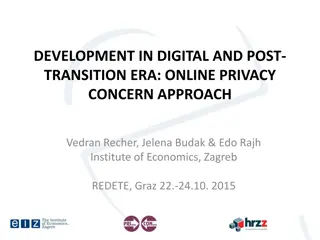Integrated Energy and Climate Plan for Bosnia and Herzegovina
The Integrated Energy and Climate Plan (NECP) outlines Bosnia and Herzegovina's roadmap towards achieving net-zero greenhouse gas emissions by 2050. It focuses on decarbonization, energy efficiency, security, internal energy market, and research and innovation. The responsible parties include the Ministry of Foreign Trade and Economic Relations, entity ministries, and technical support from international organizations. The plan includes binding targets for 2030 to reduce emissions, increase renewable energy sources, and enhance energy efficiency.
Uploaded on Mar 04, 2025 | 1 Views
Download Presentation

Please find below an Image/Link to download the presentation.
The content on the website is provided AS IS for your information and personal use only. It may not be sold, licensed, or shared on other websites without obtaining consent from the author.If you encounter any issues during the download, it is possible that the publisher has removed the file from their server.
You are allowed to download the files provided on this website for personal or commercial use, subject to the condition that they are used lawfully. All files are the property of their respective owners.
The content on the website is provided AS IS for your information and personal use only. It may not be sold, licensed, or shared on other websites without obtaining consent from the author.
E N D
Presentation Transcript
INTEGRATED ENERGY AND CLIMATE INTEGRATED ENERGY AND CLIMATE PLAN OF BOSNIA AND HERZEGOVINA PLAN OF BOSNIA AND HERZEGOVINA Dr. Admir Softi Assistant Minister for Energy Sector Ministry of Foreign Trade and Economic Relations BiH
"Energy and climate" in the EU and Bosnia and Herzegovina "Energy and climate" in the EU and Bosnia and Herzegovina Energy Community Treaty Paris Agreement (NDC) Clean energy package for all Europeans Sofia Declaration for the Western Balkans
What is NECP and who is responsible for drafting it What is NECP and who is responsible for drafting it What is NECP? Responsible parties Ministry of Foreign Trade and Economic Relations in BiH Entity ministries in the field of energy and environment Government of the Brcko District of BiH with active technical support from: Deutsche Gesellschaft f r Internationale Zusammenarbeit (GIZ) U.S. Agency for International Development Energy Sector Assistance Project (USAID EPA) United Nations Development Program (UNDP) A medium-term plan describing how a country will contribute to achieving the net zero greenhouse gas emissions target by 2050 in Europe. Realization of the NECP BiH objectives will contribute to decarbonization of the entire economy and thereby improve the competitiveness of the BiH economy in the European framework. 5 dimensions of NECP: 1. Decarbonization 2. Energy efficiency 3. Energy security 4. Internal energy market 5. Research, innovation and competitiveness
Binding targets for Bosnia and Herzegovina by 2030 Binding targets for Bosnia and Herzegovina by 2030 Greenhouse gas emissions (GHG) Share of renewable energy sources Energy efficiency - Primary energy consumption (PEC) Energy efficiency - Final energy consumption (FEC) 15.65 MtCO2 43.62% 6.84 Mtoe 4.34 Mtoe Greenhouse gas emissions (GHG) Share of renewable energy sources Energy efficiency - Primary energy consumption (PEC) Energy efficiency - Final energy consumption (FEC) 15.65 MtCO2 43.62% 6.50 Mtoe 4.34 Mtoe PEC objective is set more ambitiously than in the proposal by BiH
The binding target by 2030 The binding target by 2030 Greenhouse gases Greenhouse gases Greenhouse gas emissions, including land use, land use change and forestry (LULUCF) Total CO2eq emission with LULUCF in 2030 15.65 MtCO2 Reduction of emissions in 2030 compared to 1990 with LULUCF 41.21%
New power generation facilities until 2030. New power generation facilities until 2030. Thermal power plants: Decommissioning of 410 MW. No new fossil fuel power plants. Converting individual blocks to biomass. Renewable energy sources: Commissioning of over 2,000 MW on renewable sources. The largest increase in photovoltaic power plants of over 1,500 MW.
Key policies and measures until 2030 Key policies and measures until 2030 Reduction of GHG emissions Increased share of renewable sources Increased energy efficiency measures Adoption of the necessary legal framework and strategic documents Establishment of an organized electricity and natural gas market Establishment of greenhouse gas emissions trading schemes (EU ETS) Establishment of the Guarantee of Origin system Implementation of a just transition in coal regions Rationalization of administrative procedures Increased flexibility of the system and infrastructure Intensified research and strengthened competitiveness etc.
Establishment of a GHG emissions trading system Establishment of a GHG emissions trading system (ETS) (ETS) CBAM VS. ETS ELECTRICITY CALCULATIONDONEFORTHE CO2PRICE OF 50 EUR/TON ASSUMPTIONS: Annual report: 3,400 GWh (20% of BiH coal-based generation) The emission factor for BiH is 1,195 tCO2/MWh Sources: EU4Energy Bosnia and Herzegovina
Investment estimate by 2030 Investment estimate by 2030 Item Coal-based power generation Coal-based power generation Wind-based power generation Solar photovoltaic power generation Rationale Reconstruction and transition to biomass Building new capacities Building new capacities Building new capacities Investment estimate ( ) EUR 390.4 million EUR 539.5- 539.5 million EUR 529-635 million EUR 719-874 million Development of the electricity transmission network New interconnecting transmission lines, New TS and transmission lines, Reconstruction and rehabilitation of plants, Installation of chokes Realization of plans to expand the electricity distribution network Building new capacities Building new capacities Construction of a new interconnection for natural gas transportation, Construction of natural gas storage capacity Increasing the energy characteristics of the envelope and technical systems of buildings Increasing the energy efficiency of industrial processes Infrastructure of charging stations for electric cars, Intensifying rail transport EUR 353.2 million Development of the electricity distribution network Fossil fuel district heating systems Biomass-fueled district heating systems Infrastructure for transportation and storage of natural gas Building renovation strategy EUR 830 million EUR 50 million EUR 51.1 million EUR 490 million BAM 13.5 billion to 16 billion EUR 1050 million Industry Transport infrastructure EUR 665 million EUR 275 million Costs of a just transition Mine closure, land rehabilitation, other socio-economic issues EUR 465-1,395 million Forestry Human health EUR 10 million EUR 7 million
Coming up: Coming up: PANEL I PANEL I - - Energy sector in Bosnia and Energy sector in Bosnia and Herzegovina: Between energy transition Herzegovina: Between energy transition and crisis and crisis
